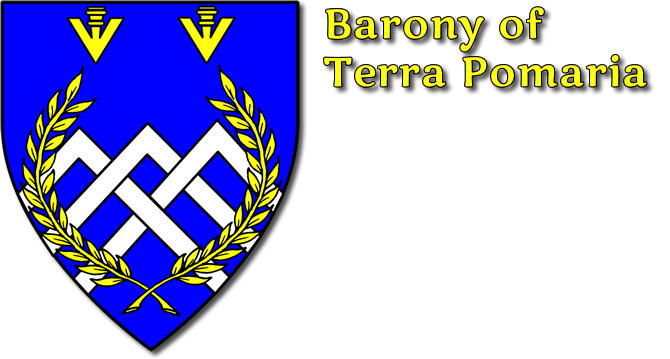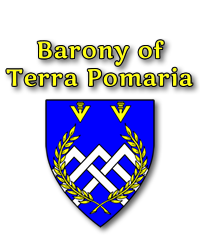19 Jan De Limonia (Lemon Chicken)
Then Serve It Forth…
By Lady Rosemary Willowwood de Ste. Anne
This month’s column begins our exploration of recipes from areas we don’t usually visit in our culinary quest. I will also take a look at some of the origins and possible sources of inspiration among cooks, and willingness to adapt techniques when religion and other considerations get in the way of producing good eating. Our first look is from a collection which MAY BE from France, but I have included it in this unfamiliar category because it was found bound in a Latin codex which contained essays on many other subjects including hunting, medicine agriculture and the natural sciences, not cooking alone. It is a reminder that cooking interacts with many other concerns, and is not separately categorized, the way we modernly do.
“De Limonia” (Lemony chicken)
From Liber de coquina (14th or 15th c.)
Marianne Mulon, ed., in “Deux traités inédites d’art culinaire médiéval”
Bulletin philologique et historique 1 (1971)
Ad limoniam faciendam, suffrigantur pulli cum lardo et cepis. Et amigdale mundate terantur, distemperentur cum brodio carnis et colentur. Que coquantur cum dictis pullis et speciebus. Et si non habentur amigdale, spissetur brodium cum uitellis ouorum. Et si fuerit prope horam scutellandi, pone ibi succum limonum uel limiarum vel citrangulorum.
TRANSLATION: Here again, the translation is by Odile Redon, Francoise Sabban and Silvano Serventi in their MARVELOUS book, The Medieval Kitchen, which I cannot recommend highly enough. (University of Chicago Press; find it and buy it!) To make limonia, fry chickens with fat and onions. And crush some skinned almonds, moisten with meat broth, and strain. Cook with the chickens and spices. If you have no almonds, thicken the broth with egg yolks. When the time to serve nears, add the juice of lemons, limes, or bitter oranges.
REALIZATION: Brown parts from a chicken well in oil over medium-high heat. The recipe recommends lard, but you can use any mild oil. (This realization is sized for a whole chicken cut up, or about two pounds of your favorite variety of parts.) When you turn the chicken to brown the second side, add one medium onion or several shallots, finely chopped. Continue to brown, taking care that the onion browns, but does not burn. Add about 1½ cups of almond milk made with chicken broth. (If you don’t have time to make the almond milk, you can use a cup of commercial almond milk and ½ cup of canned condensed chicken broth.). Add 1-2 tsp. of your choice of spices; coriander is a possibility if you want a savory dish, or ginger, if you want a more aromatic dish (you may notice the recipe does not specify WHICH spice, and leaves the choice to the cook’s taste and larder). Simmer uncovered for about 30 minutes, turning the pieces once more during that time. Add 1/3 cup lemon juice, and the zest of the lemon. If the broth requires additional thickening, remove the chicken pieces and keep warm in a low oven. Thicken the sauce with one beaten egg, and pour back over the chicken pieces. Garnish with a slice of lemon and serve.
The authors of The Medieval Kitchen comment that the use of lemons and almond milk imply a Middle Eastern origin for the dish, but states that the use of lard to fry the chicken argues against it. I would like to differ with them a bit. The origin may well have been Middle Eastern, as the use of fruit with meat would imply. Other Middle Eastern recipes for chicken, including one for a dish soured with lemon or verjuice, from A Baghdad Cookery Book by Al Baghdadi, specified “fresh sesame oil” for frying the chicken. However, cooks being the inventive folks that they are, they would have observed Middle Eastern cooks rendering fat from “tail”, or the fatty deposits from the tails of certain sheep, to fry other meats in for similar stewed dishes. Remembering how difficult it was to get seed oils in Europe (the Pope actually gave a dispensation for Northern Europeans to use butter during Lent “because they could get no good olive oil), those enterprising cooks would have recognized the process as the same as rendering pork fat for lard. Having no prohibition against using products from a pig, they quickly would have browned their chicken in the ubiquitous lard and gone about their business. To the great benefit of our culinary library; you pick up the good stuff wherever you find it!
GLOSSARY:
Tail: Fat from the tail of the sheep most often seen in Middle East, which are a special breed, Damara or Karakul sheep (often called “fat-tail sheep”) with such a fat tail that it might drag on the ground if not docked. The tail is a prized source of cooking fat. It is a natural fat-storage mechanism like a camel’s hump, and renders with very little “cracklin’” residue.



